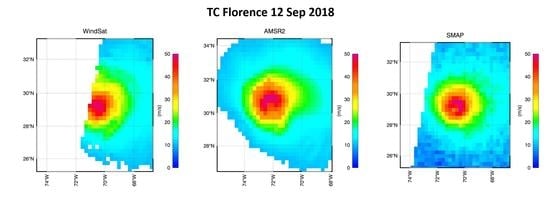Tropical Cyclone Wind Speeds from WindSat, AMSR and SMAP: Algorithm Development and Testing
Abstract
1. Introduction
2. Wind Speed Retrieval Algorithms in Tropical Cyclones for C-X Band Sensors
2.1. TC Match-Up Sets between WindSat Brightness Temperatures and SMAP Wind Speeds
2.2. C-X Band Combinations with Reduced Rain Contamination
and thus
2.3. Statistical Linear Regressions for C/X-Band Channels
2.4. AMSR TC-Wind Algorithm
2.5. Error Sources
- There is radiometer noise, calibration uncertainties or pointing errors in the WindSat or AMSR TB. These uncertainties already enter into standard rain-free wind speed retrievals. From validation studies that have been performed [1,6,7], we can estimate their magnitude amount to wind speed errors of 1 m/s or less.
- Wind direction error: We have neglected wind direction in the TC-wind retrievals. The size of the wind direction signal in the surface emissivity at the C- and X-band ranges from about 1 K at 15 m/s to 2 K at very high winds [52], which translates into an error of at least 1–2 m/s in the retrieved wind speeds.
- There might be environmental parameters other than wind speed or direction that could impact the ocean surface roughness and the microwave emission from it (e.g., wave height or wave direction).
- There are uncertainties in the radiometer rain rate R that is used as input to the regression (5).
- For the AMSR TC-wind retrieval, there can be errors in the RTM adjustment (6) or in the input parameters that are needed in the computation of (6), such as SST, V, L and R.
- There is variability in the atmospheric conditions that are present within the TC, in particular the atmospheric moisture and temperature.
- In very heavy precipitation (10 mm/h rain rate and higher), the contribution of atmospheric scattering by rain droplets starts increasing for the higher X-band frequency channels. We have neglected scattering in our approach. The argument from Section 2.2. breaks down and so does the training of the TC-wind algorithm from Section 2.3. Atmospheric scattering leads to a decrease in the TOA TB and thus has the opposite effect from atmospheric absorption, which increases the TOA TB [15]. Therefore, atmospheric scattering can result in a negative bias in the retrieved wind speed.
- There is noise in the SMAP wind speeds that were used for training the WindSat TC-wind algorithm.
2.6. Data Processing and Distribution
3. Time Series of Intensity and Size of Selected Tropical Cyclones
- The storm intensity, which is defined as the maximum 1-min sustained wind speed.
- The maximum radii of the gale-force (34 kt, 17.5 m/s), storm-force (50 kt, 25.7 m/s) and the hurricane force (64 kt, 33 m/s) winds, labelled R34, R50, R64, in each quadrant NE, SE, SW, NW.
4. Extension to X-K Band Sensors
5. Extension to Global All-Weather Wind Retrievals
5.1. WindSat—SMAP—NCEP Match-Up Set
5.2. Training of the Global All-Weather Wind Algorithm
5.3. Validation with Buoy Wind Speeds
5.4. Example of Extra-Tropical Cyclone
6. Summary and Conclusions
Author Contributions
Funding
Data Availability Statement
Acknowledgments
Conflicts of Interest
References
- Wentz, F. A well-calibrated ocean algorithm for special sensor microwave/imager. J. Geophys. Res. 1997, 102, 8703–8718. [Google Scholar] [CrossRef]
- Wentz, F.; Meissner, T. Algorithm Theoretical Basis Document (ATBD), Version 2, AMSR Ocean Algorithm, RSS Tech. Report 121599A-1, Remote Sensing Systems, Santa Rosa, CA, 66 p. 2000. Available online: http://images.remss.com/papers/rsstech/2000_121599A-1_Wentz_AMSR_Ocean_Algorithm_ATBD_Version2.pdf (accessed on 14 February 2021).
- Wentz, F.; Meissner, T. Algorithm Theoretical Basis Document (ATBD), Supplement 1, AMSR Ocean Algorithm, RSS Tech. Report 1051707, Remote Sensing Systems, Santa Rosa, CA, 6 pp. 2006. Available online: http://images.remss.com/papers/rsstech/2007_051707_Wentz_AMSR_Ocean_Algorithm_Version_2_Supplement1_ATBD.pdf (accessed on 14 February 2021).
- Meissner, T.; Wentz, F. Ocean Retrievals for WindSat. In Proceedings of the IEEE MicroRad, San Juan, PR, USA, 28 February–8 March 2006; pp. 119–124. Available online: http://images.remss.com/papers/rssconf/Meissner_microrad_2006_puertorico_windsat.pdf (accessed on 14 February 2021). [CrossRef]
- Bettenhausen, M.; Smith, C.; Bevilacqua, R.; Wang, N.-Y.; Gaiser, P.; Cox, S. A nonlinear optimization algorithm for WindSat wind vector retrievals. IEEE Trans. Geosci. Remote Sens. 2006, 44, 597–610. [Google Scholar] [CrossRef]
- Wentz, F. A 17-Yr Climate Record of Environmental Parameters Derived from the Tropical Rainfall Measuring Mission (TRMM) Microwave Imager. J. Clim. 2015, 28, 6882–6902. [Google Scholar] [CrossRef]
- Wentz, F.; Ricciardulli, L.; Rodriguez, E.; Stiles, B.W.; Bourassa, M.A.; Long, D.; Hoffman, R.N.; Stoffelen, A.; Verhoef, A.; ONeill, L.W.; et al. Evaluating and extending the ocean winds data climate record. J. Select. Topics Appl. Earth Observ. Remote Sens. 2017, 99, 2165–2185. [Google Scholar] [CrossRef]
- Wentz, F.; Meissner, T.; Gentemann, C.; Brewer, M. Remote Sensing Systems AQUA AMSR-E Daily Environmental Suite on 0.25 deg grid, Version 7.0, Wind Speed, Water Vapor, Cloud Liquid Water and Rain Rate. Remote Sensing Systems, Santa Rosa, CA. 2014. Available online: www.remss.com/missions/amsr (accessed on 14 February 2021).
- Wentz, F.; Meissner, T.; Gentemann, C.; Hilburn, K.; Scott, J. Remote Sensing Systems GCOM-W1 AMSR2 Daily Environmental Suite on 0.25 deg grid, Version 8.0, Wind Speed, Water Vapor, Cloud Liquid Water and Rain Rate. Remote Sensing Systems, Santa Rosa, CA. 2014. Available online: www.remss.com/missions/amsr (accessed on 14 February 2021).
- Wentz, F.; Ricciardulli, L.; Gentemann, C.; Meissner, T.; Hilburn, K.; Scott, J. Remote Sensing Systems Coriolis WindSat Daily Environmental Suite on 0.25 deg grid, Version 7.0.1, Wind Speed and Rain Rate. Remote Sensing Systems, Santa Rosa, CA. 2013. Available online: www.remss.com/missions/windsat (accessed on 14 February 2021).
- Kawanishi, T.; Sezai, T.; Ito, Y.; Imaoka, K.; Takeshima, T.; Ishido, Y.; Shibata, A.; Miura, M.; Inahata, H.; Spencer, R.W. The Advanced Microwave Scanning Radiometer for the Earth Observing System (AMSR-E), NASDA’s contribution to the EOS for global energy and water cycle studies. IEEE Trans. Geosci. Remote Sens. 2003, 41, 184–904. [Google Scholar] [CrossRef]
- Imaoka, K.; Kachi, M.; Kasahara, M.; Ito, N.; Nakagawa, K.; Oki, T. Instrument performance and calibration of AMSR-E and AMSR2. In International Archives of the Photogrammetry, Remote Sensing and Spatial Information Science; International Society for Photogrammetry and Remote Sensing: Kyoto, Japan, 2010; Volume 38, pp. 13–16. Available online: https://www.isprs.org/proceedings/XXXVIII/part8/pdf/JTS13_20100322190615.pdf (accessed on 14 February 2021).
- Oki, T.; Imaoka, K.; Kachi, M. AMSR instruments on GCOM-W1/2: Concepts and applications. In Proceedings of the 2010 IEEE International Geoscience and Remote Sensing Symposium, Honolulu, HI, USA, 25–30 July 2010; pp. 1363–1366. [Google Scholar] [CrossRef]
- Gaiser, P.W.; St Germain, K.M.; Twarog, E.M.; Poe, G.A.; Purdy, W.; Richardson, D.; Grossman, W.; Jones, W.L.; Spencer, D.; Golba, G. The WindSat spaceborne polarimetric microwave radiometer: Sensor description and early orbit performance. IEEE Trans. Geosci. Remote Sens. 2004, 42, 2347–2361. [Google Scholar] [CrossRef]
- Liou, K. An Introduction to Atmospheric Radiation, 2nd ed.; Elsevier Science: Amsterdam, The Netherlands, 2002; p. 583. [Google Scholar]
- Jones, W.L.; Black, P.; Delnore, V.; Swift, C. Airborne Microwave Remote-Sensing Measurements of Hurricane Allen. Science 1981, 214, 274–280. [Google Scholar] [CrossRef] [PubMed]
- Uhlhorn, E.; Black, P. Verification of Remotely Sensed Sea Surface Winds in Hurricanes. J. Atmos. Ocean. Technol. 2003, 20, 99–116. [Google Scholar] [CrossRef]
- Uhlhorn, E.; Franklin, J.; Goodberlet, M.; Carswell, J.; Goldstein, A. Hurricane surface wind measurements from an operational stepped frequency microwave radiometer. Mon. Wea. Rev. 2007, 135, 3070–3085. [Google Scholar] [CrossRef]
- El-Nimri, S.; Jones, W.L.; Uhlhorn, E.; Ruf, C.; Johnson, J.; Black, P. An improved C-band ocean surface emissivity model at hurricane-force wind speeds over a wide range of Earth incidence angles. IEEE Geosci. Remote Sens. Lett. 2010, 7, 641–645. [Google Scholar] [CrossRef]
- Klotz, B.; Uhlhorn, E. Improved Stepped Frequency Microwave Radiometer tropical cyclone surface winds in heavy precipitation. J. Atmos. Ocean. Technol. 2014, 31, 2392–2408. [Google Scholar] [CrossRef]
- Holbach, H.; Uhlhorn, E.; Bourassa, M. Off-Nadir SFMR Brightness Temperature Measurements in High-Wind Conditions. J. Atmos. Ocean. Technol. 2018, 35, 1865–1879. [Google Scholar] [CrossRef]
- Sapp, J.; Alsweiss, S.; Jelenak, Z.; Chang, P.; Carswell, J. Stepped Frequency Microwave Radiometer wind-speed retrieval improvements. Remote Sens. 2019, 11, 214. [Google Scholar] [CrossRef]
- Meissner, T.; Wentz, F. Wind vector retrievals under rain with passive satellite microwave radiometers. IEEE Trans. Geosci. Remote Sens. 2009, 47, 3065–3083. [Google Scholar] [CrossRef]
- Meissner, T.; Ricciardulli, L.; Wentz, F. All-weather wind vector measurements from intercalibrated active and passive microwave satellite sensors. In Proceedings of the 2011 IEEE Int. Geoscience and Remote Sensing Symp. (IGARSS), Vancouver, BC, Canada, 24–29 July 2011; IEEE: Piscataway, NJ, USA, 2011. [Google Scholar] [CrossRef]
- Zhang, L.; Yin, X.; Shi, H.; Wang, Z. Hurricane Wind Speed Estimation Using WindSat 6 and 10 GHz Brightness Temperatures. Remote Sens. 2016, 8, 721. [Google Scholar] [CrossRef]
- Shibata, A. A wind speed retrieval algorithm by combining 6 and 10 GHz data from Advanced Microwave Scanning Radiometer: Wind speed inside hurricanes. J. Oceanogr. 2006, 62, 351–359. [Google Scholar] [CrossRef]
- Zabolotskikh, E.; Mitnik, L.; Bertrand, C. New approach for severe marine weather study using satellite passive microwave sensing, Geophys. Res. Lett. 2013, 40, 3347–3350. [Google Scholar] [CrossRef]
- Zabolotskikh, E.; Mitnik, L.; Bertrand, C. GCOM-W1 AMSR2 and MetOp-A ASCAT wind speeds for the extratropical cyclones over the North Atlantic. Remote Sens. Environ. 2014, 147, 89–98. [Google Scholar] [CrossRef]
- Zabolotskikh, E.; Mitnik, L.; Reul, N.; Chapron, B. New possibilities for geophysical parameter retrievals opened by GCOM-W1 AMSR2. IEEE J. Sel. Top. Appl. Earth Obs. Remote Sens. 2015, 8, 4248–4261. [Google Scholar] [CrossRef]
- Mai, M.; Zhang, B.; Li, X.; Hwang, P.; Zhang, J. Application of AMSR-E and AMSR2 low-frequency channel brightness temperature data for hurricane wind retrievals. IEEE Trans. Geosci. Remote Sens. 2016, 54, 4501–4512. [Google Scholar] [CrossRef]
- Powell, M.; Houston, S.; Amat, L.; Morisseau-Leroy, N. The HRD real time hurricane wind analysis system. J. Wind Eng. Ind. Aerodyn. 1998, 77–78, 53–64. [Google Scholar] [CrossRef]
- DiNapoli, S.; Bourassa, M.; Powell, M. Uncertainty and intercalibration analysis of H*Wind. J. Atmos. Oceanic Technol. 2012, 29, 822–833. [Google Scholar] [CrossRef]
- Meissner, T.; Ricciardulli, L.; Wentz, F. Capability of the SMAP Mission to measure ocean surface winds in storms. Bull. Amer. Meteor. Soc. 2017, 98, 1660–1677. [Google Scholar] [CrossRef]
- Meissner, T.; Ricciardulli, L.; Wentz, F. Remote Sensing Systems SMAP daily Sea Surface Winds Speeds on 0.25 deg grid, Version 01.0. FINAL. Remote Sensing Systems, Santa Rosa, CA. 2018. Available online: www.remss.com/missions/smap/ (accessed on 14 February 2021).
- Entekhabi, D.; Njoku, E.G.; O’Neill, P.E.; Kellogg, K.H.; Crow, W.; Edelstein, W.N.; Entin, J.; Goodman, S.D.; Jackson, T.J.; Johnson, J.T.; et al. The Soil Moisture Active Passive (SMAP) mission. Proc. IEEE 2010, 98, 704–716. [Google Scholar] [CrossRef]
- Entekhabi, D.; Yueh, S.; O’Neill, P.; Kellogg, K.; Allen, A.; Bindlish, R.; Brown, M.; Chan, S.; Colliander, A.; Crow, W.; et al. SMAP Handbook. National Aeronautics and Space Administration. 2014; p. 192. Available online: https://smap.jpl.nasa.gov/mission/description/ (accessed on 14 February 2021).
- Wentz, F. The effect of clouds and rain on the Aquarius salinity retrieval. RSS Tech. Report 3031805, Remote Sensing Systems, Santa Rosa, CA, 14 p. 2005. Available online: http://images.remss.com/papers/aquarius/rain_effect_on_salinity.pdf (accessed on 14 February 2021).
- Reul, N.; Tenerelli, J.; Chapron, B.; Vandemark, D.; Quilfen, Y.; Kerr, Y. SMOS satellite L-band radiometer: A new capability for ocean surface remote sensing in hurricanes. J. Geophys. Res. 2012, 117, C02006. [Google Scholar] [CrossRef]
- Reul, N.; Chapron, B.; Zabolotskikh, E.; Donlon, C.; Quilfen, Y.; Guimbard, S.; Piolle, J. A revised L-band radio-brightness sensitivity to extreme winds under tropical cyclones: The five year SMOS-storm data-base. Remote Sens. Environ. 2016, 180, 274–291. [Google Scholar] [CrossRef]
- Yueh, S.; Fore, A.; Tang, W.; Hayashi, A.; Stiles, B.; Reul, N.; Wengi, Y.; Zhang, F. SMAP L-band passive microwave observations of ocean surface wind during severe storms. IEEE Trans. Geosci. Rem. Sens. 2016, 54, 7339–7350. [Google Scholar] [CrossRef]
- Reul, N.; Chapron, B.; Zabolotskikh, E.; Donlon, C.; Mouche, A.; Tenerelli, J.; Collard, F.; Piolle, J.; Fore, A.; Yueh, S.; et al. A new generation of tropical cyclone size measurements from space. Bull. Amer. Meteor. Soc. 2017, 98, 2367–2385. [Google Scholar] [CrossRef]
- Fore, A.; Yueh, S.; Stiles, B.; Tang, W.; Hayashi, A. SMAP radiometer-only tropical cyclone intensity and size validation. IEEE Geosci. Remote Sens. Lett. 2018, 15, 1480–1484. [Google Scholar] [CrossRef]
- Manaster, A.; Ricciardulli, L.; Meissner, T. Validation of high ocean surface winds from satellites using oil platform anemometers. J. Atmos. Oceanic Technol. 2019, 36, 803–818. [Google Scholar] [CrossRef]
- Manaster, A.; Ricciardulli, L.; Meissner, T. Tropical Cyclone Wind Speeds from AMSR, WindSat and SMAP: Comparison with the HWRF Model. Remote Sens. 2021. submitted. [Google Scholar]
- Poe, G. Optimum interpolation of imaging microwave radiometer data. IEEE Trans. Geosci. Rem. Sens. 1990, 28, 800–810. [Google Scholar] [CrossRef]
- Meissner, T.; Wentz, F.; Draper, D. GMI Calibration Algorithm and Analysis Theoretical Basis Document, Version G, RSS Tech. Report 041912, Remote Sensing Systems, Santa Rosa, CA, 124 p. 2012. Available online: http://images.remss.com/papers/rsstech/2012_041912_Meissner_GMI_ATBD_vG.pdf (accessed on 14 February 2021).
- Meissner, T.; Wentz, F.; Ricciardulli, L. The emission and scattering of L-band microwave radiation from rough ocean surfaces and wind speed measurements from Aquarius. J. Geophys. Res. Oceans 2014, 119, 6499–6522. [Google Scholar] [CrossRef]
- Reynolds, R.; Smith, T.; Liu, C.; Chelton, D.; Casey, K.; Schlax, M. Daily high-resolution blended analyses for sea surface temperature. J. Climate 2007, 20, 5473–5496. [Google Scholar] [CrossRef]
- NOAA Optimum Interpolation Sea Surface Temperature (OISST) v2.1. 2020. Available online: https://www.ncdc.noaa.gov/oisst/optimum-interpolation-sea-surface-temperature-oisst-v21 (accessed on 14 February 2021).
- Wentz, F.; Spencer, R. SSM/I rain retrievals within a unified All-weather ocean algorithm. J. Atmos. Sci. 1998, 55, 1613–1627. [Google Scholar] [CrossRef]
- Hilburn, K.; Wentz, F. Intercalibrated passive microwave rain products from the Unified Microwave Ocean Retrieval Algorithm (UMORA). J. Appl. Meteor. Climatol. 2008, 47, 778–794. [Google Scholar] [CrossRef]
- Meissner, T.; Wentz, F. The emissivity of the ocean surface between 6 and 90 GHz over a large range of wind speeds and Earth incidence angles. IEEE Trans. Geosci. Rem. Sens. 2012, 50, 3004–3026. [Google Scholar] [CrossRef]
- Ashcroft, P.; Wentz, F. AMSR Level 2A Algorithm Theoretical Basis Document, RSS Tech. Report 121599B-1, Remote Sensing Systems, Santa Rosa, CA, p. 29. 2000. Available online: http://images.remss.com/papers/rsstech/2000_121599B-1_Wentz_AMSR_Level2A_Algorithm_ATBD.pdf (accessed on 14 February 2021).
- Wentz, F.; Gentemann, C.; Ashcroft, P. On-orbit calibration of AMSR-E and the retrieval of ocean products, presented at 83rd AMS Annual Meeting, Long Beach, CA. 2003. Available online: http://images.remss.com/papers/rssconf/Wentz_AMS_2003_LongBeach_AMSRE_calibration.pdf (accessed on 14 February 2021).
- Wentz, F. Updates to the AMSR-E Level-2A Version B07 Algorithm, RSS Tech. Report 013006, Remote Sensing Systems, Santa Rosa, CA, p. 29. 2000. Available online: http://images.remss.com/papers/rsstech/2006_013006_Wentz_AMSRE_L2A_Version_B07_Updates.pdf (accessed on 14 February 2021).
- Meissner, T.; Wentz, F. The complex dielectric constant of pure and sea water from microwave satellite observations. IEEE Trans. Geosci. Rem. Sens. 2004, 42, 1836–1849. [Google Scholar] [CrossRef]
- Wentz, F.; Meissner, T. Atmospheric absorption model for dry air and water vapor at microwave frequencies below 100 GHz derived from spaceborne radiometer observations. Radio Sci. 2016, 51. [Google Scholar] [CrossRef]
- Dvorak, V. Tropical cyclone intensity analysis and forecasting from satellite imagery. Mon. Wea. Rev. 1975, 103, 420–430. [Google Scholar] [CrossRef]
- Sampson, C.; Schrader, J. The Automated Tropical Cyclone Forecasting System (version 3.2). Bull. Amer. Meteor. Soc. 2000, 81, 1231–1240. [Google Scholar] [CrossRef]
- Velden, C.; Harper, B.; Wells, F.; Beven, J.L., II; Zehr, R.; Olander, T.; Mayfield, M.; Lander, M.; Edson, R.; Avila, L. The Dvorak tropical cyclone intensity estimation technique: A satellite-based method that has endured for over 30 years. Bull. Amer. Meteor. Soc. 2006, 87, 1195–1210. [Google Scholar] [CrossRef]
- Knapp, K.; Kruk, M.; Levinson, D.; Diamond, H.; Neumann, C. The International Best Track Archive for Climate Stewardship (IBTrACS): Unifying tropical cyclone best track data. Bull. Amer. Meteor. Soc. 2010, 91, 363–376. [Google Scholar] [CrossRef]
- Knaff, J.; Brown, D.; Courtney, J.; Gallina, G.; Beven, J. An evaluation of Dvorak Technique-based tropical cyclone intensity estimates. Wea. Forecast. 2010, 25, 1362–1379. [Google Scholar] [CrossRef]
- Knaff, J.; DeMaria, M.; Molenar, D.; Sampson, C.; Seybold, M. An automated, objective, multi-satellite platform tropical cyclone surface wind analysis. J. Appl. Meteorol. Climatol. 2011, 50, 2149–2166. [Google Scholar] [CrossRef]
- Landsea, C.; Franklin, J. Atlantic hurricane database uncertainty and presentation of a new database format. Mon. Wea. Rev. 2013, 141, 3576–3592. [Google Scholar] [CrossRef]
- Knaff, J.; Sampson, C. After a decade are Atlantic tropical cyclone gale force wind radii forecasts now skillful? Wea. Forecast. 2015, 30, 702–709. [Google Scholar] [CrossRef]
- Sampson, C.; Knaff, J. A consensus forecast for tropical cyclone gale wind radii. Wea. Forecast. 2015, 30, 1397–1403. [Google Scholar] [CrossRef]
- Knaff, J.; Slocum, C.; Musgrave, K.; Sampson, C.; Strahl, B. Using routinely available information to es-timate tropical cyclone wind structure. Mon. Wea. Rev. 2016, 144, 1233–1247. [Google Scholar] [CrossRef]
- Sampson, C.; Fukada, E.; Knaff, J.; Strahl, B.; Brennan, M.; Marchok, T. Tropical cyclone gale wind radii estimates for the western North Pacific. Wea. Forecast. 2017, 32, 1029–1040. [Google Scholar] [CrossRef]
- Sampson, C.; Goerss, J.; Knaff, J.; Strahl, B.; Fukada, E.; Serra, E. Tropical cyclone gale wind radii estimates, forecasts and error forecast for the western North Pacific. Wea. Forecast. 2018, 33, 1081–1092. [Google Scholar] [CrossRef]
- National Hurricane Center Data Archive. Available online: https://www.nhc.noaa.gov/data/ (accessed on 14 February 2021).
- Joint Typhoon Warning Center Best Track Archive, Naval Oceanography Archive. Available online: https://www.metoc.navy.mil/jtwc/jtwc.html?best-tracks (accessed on 14 February 2021).
- Verspeek, J.; Stoffelen, A.; Portabella, M.; Bonekamp, H.; Anderson, C.; Figa-Saldaña, J. Validation and calibration of ASCAT using CMOD5.n. IEEE Trans. Geosci. Remote Sens. 2010, 48, 386–395. [Google Scholar] [CrossRef]
- Olander, T.; Velden, C. The Advanced Dvorak Technique (ADT) for estimating tropical cyclone intensity: Update and new capabilities. Wea. Forecast. 2019, 34, 905–922. [Google Scholar] [CrossRef]
- Velden, C.; Herndon, D. A consensus approach for estimating tropical cyclone intensity from meteoro-logical satellites: SATCON. Wea. Forecast. 2020, 35, 1645–1662. [Google Scholar] [CrossRef]
- Cooperative Institute for Meteorological Satellite Studies, Space Science and Engineering Center/University of Wisconsin-Madison. TC Webpage Product Archive: SATCON. Available online: http://tropic.ssec.wisc.edu (accessed on 14 February 2021).
- Mayers, D.; Ruf, C. Estimating the true maximum sustained wind speed of a tropical cyclone from spatially averaged observations. J. Appl. Meteorol. Clim. 2020, 59, 251–262. [Google Scholar] [CrossRef]
- Harper, B.; Kepert, J.; Ginger, J. Guidelines for Converting between Various Wind Averaging Periods in Tropical Cyclone Conditions. World Metrological Organization WMO/TD 1555, 2010; p. 64. Available online: https://library.wmo.int/doc_num.php?explnum_id=290 (accessed on 14 February 2021).
- Kaplan, J.; DeMaria, M.; Knaff, J. A Revised Tropical Cyclone Rapid Intensification Index for the Atlantic and Eastern North Pacific Basins. Weather Forecast. 2010, 25, 220–241. [Google Scholar] [CrossRef]
- Mayers, D.; Ruf, C. MTrack: Improved Center Fix of Tropical Cyclones from SMAP Wind Observations. Bull. Amer. Meteor. Soc. 2020. [Google Scholar] [CrossRef]
- Kummerow, C.; Barnes, W.; Kozu, T.; Shiue, J.; Simpson, J. The Tropical Rainfall Measuring Mission (TRMM) sensor package. J. Atmos. Oceanic Technol. 1998, 15, 809–817. [Google Scholar] [CrossRef]
- Draper, D.; Newell, D.; Wentz, F.; Krimchansky, S.; Skofronick-Jackson, G. The Global Precipitation Meas-urement (GPM) Microwave Imager (GMI): Instrument overview and early on-orbit performance. IEEE J. Sel. Top. Appl. Earth Obs. Remote Sens. 2015, 8, 3452–3462. [Google Scholar] [CrossRef]
- Weather System Follow-on, Ball Aerospace. Available online: https://www.ball.com/aerospace/getmedia/d2ba7f42-c3dc-41e6-9114-016acb1906c5/D3395_WSF_1.pdf.aspx?ext=.pdf (accessed on 14 February 2021).
- Weather System Follow-on, eoPortal: Satellite Missions. Available online: https://directory.eoportal.org/web/eoportal/satellite-missions/content/-/article/wsf-m (accessed on 14 February 2021).
- Boutin, J.; Chao, Y.; Asher, W.E.; Delcroix, T.; Drucker, R.; Drushka, K.; Kolodziejczyk, N.; Lee, T.; Reul, N.; Reverdin, G.; et al. Satellite and in situ salinity: Understanding near-surface stratification and subfootprint variability. Bull. Amer. Meteor. Soc. 2016, 97, 1391–1407. [Google Scholar] [CrossRef]
- National Centers for Environmental Prediction (NCEP) Global Data Assimilation System (GDAS) Model 10-m Winds (at 0.25° Resolution). Available online: www.nco.ncep.noaa.gov/pmb/products/gfs/ (accessed on 14 February 2021).
- Portmann, H. Handbook of Automated Data Quality Control Checks and Procedures. National Data Buoy Center Tech. Doc. 09–02. 2009; p. 78. Available online: http://www.ndbc.noaa.gov/NDBCHandbookofAutomatedDataQualityControl2009.pdf (accessed on 14 February 2021).
- National Data Buoy Center: Data Access. Available online: https://www.ndbc.noaa.gov/ (accessed on 14 February 2021).
- McPhaden, M.J.; Busalacchi, A.J.; Cheney, R.; Donguy, J.-R.; Gage, K.S.; Halpern, D.; Ji, M.; Julian, P.; Meyers, G.; Mitchum, G.T.; et al. The Tropical Ocean–Global Atmosphere (TOGA) observing system: A decade of progress. J. Geophys. Res. 1998, 103, 14169–14240. [Google Scholar] [CrossRef]
- Pacific Marine Environmental Laboratory: Data Access. Available online: https://www.pmel.noaa.gov/ (accessed on 14 February 2021).
- Bourles, B.; Lumpkin, R.; Mcphaden, M.J.; Hernandez, F.; Nobre, P.; Campos, E.J.D.; Yu, L.; Planton, S.; Busalacchi, A.; Moura, A.D.; et al. The PIRATA program: History, accomplishments, and future directions. Bull. Amer. Meteor. Soc. 2008, 89, 1111–1125. [Google Scholar] [CrossRef]
- McPhaden, M.J.; Meyers, G.; Ando, K.; Masumoto, Y.; Murty, V.S.N.; Ravichandran, M.; Syamsudin, F.; Vialard, J.; Yu, L.; Yu, W. RAMA: The Research Moored Array for African–Asian–Australian Monsoon Analysis and Prediction. Bull. Amer. Meteor. Soc. 2009, 90, 459–480. [Google Scholar] [CrossRef]
- Gower, J. Temperature, wind, and wave climatologies, and trends from marine meteorological buoys in the northeast Pacific. J. Clim. 2002, 15, 3709–3718. [Google Scholar] [CrossRef]
- Fisheries and Oceans Canada: Marine Environmental Data Section. Available online: http://www.meds-sdmm.dfo-mpo.gc.ca/isdm-gdsi/waves-vagues/index-eng.htm (accessed on 14 February 2021).
- Mears, C.; Smith, D.; Wentz, F. Comparison of Special Sensor Microwave Imager and buoy-measured wind speeds from 1987 to 1997. J. Geophys. Res. 2001, 106, 11719–11729. [Google Scholar] [CrossRef]
- Ricciardulli, L.; Wentz, F. Remote Sensing Systems ASCAT Daily Ocean Vector Winds on 0.25 deg grid, Version 02.1, Wind Speed. Remote Sensing Systems, Santa Rosa, CA. 2016. Remote Sensing Systems. 2016. Available online: www.remss.com/missions/ascat (accessed on 14 February 2021).
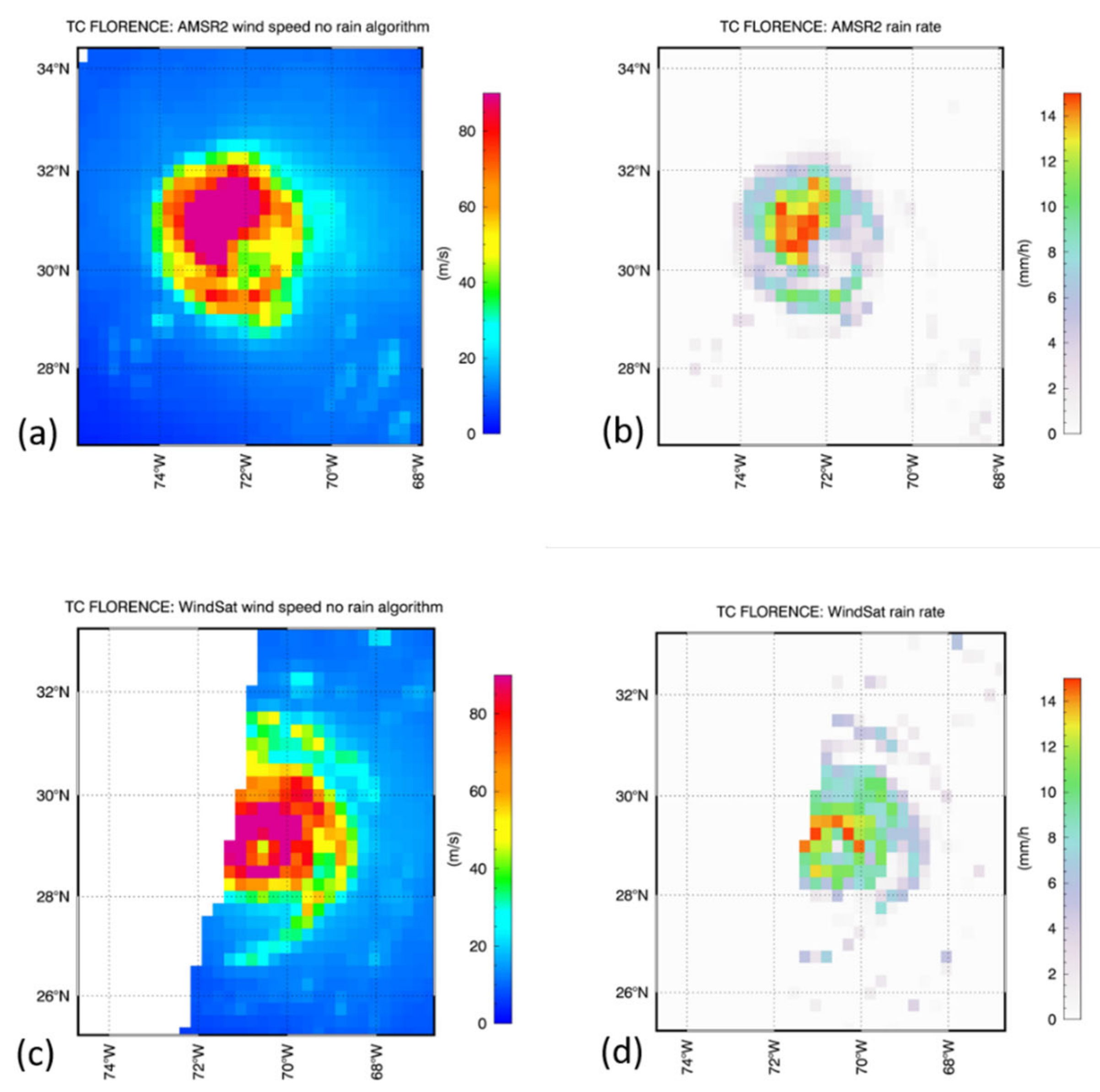
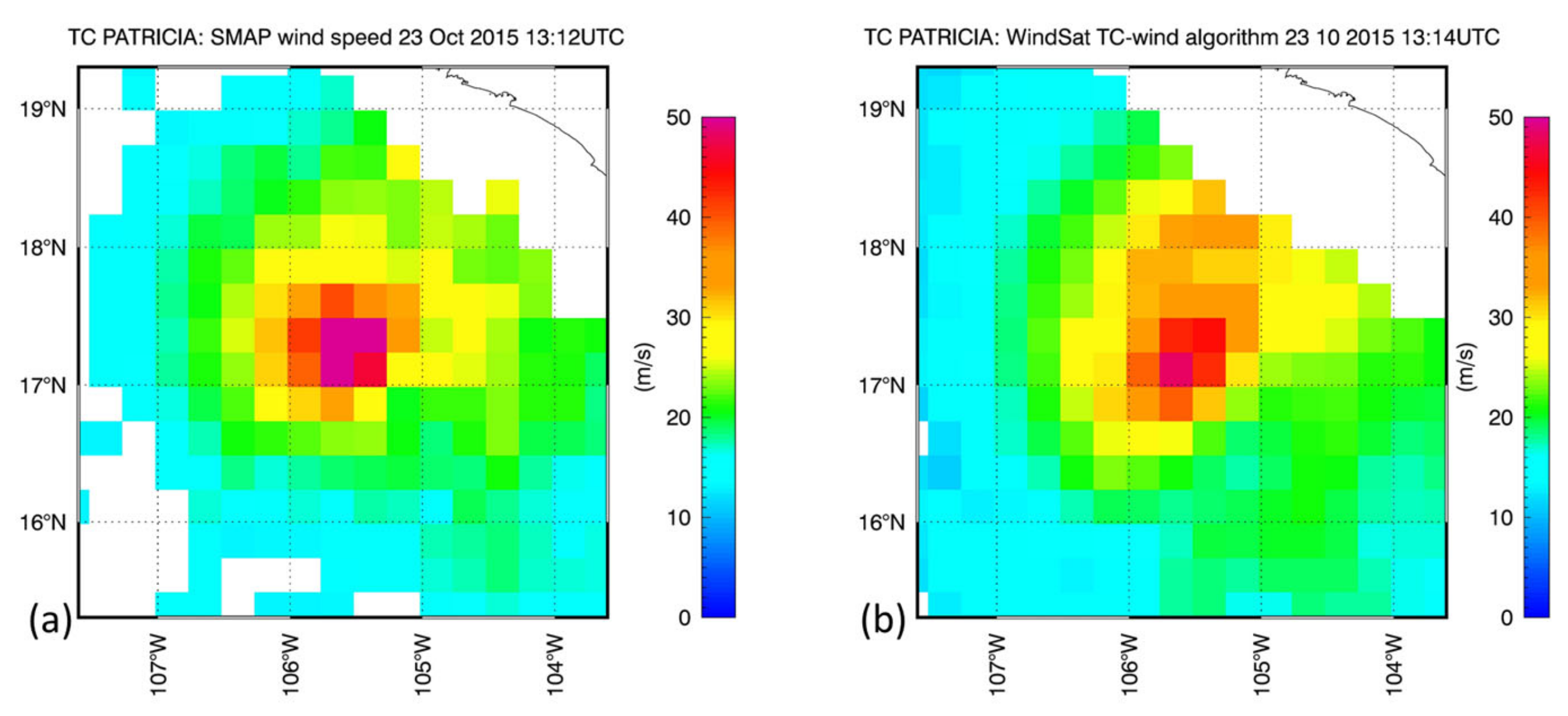
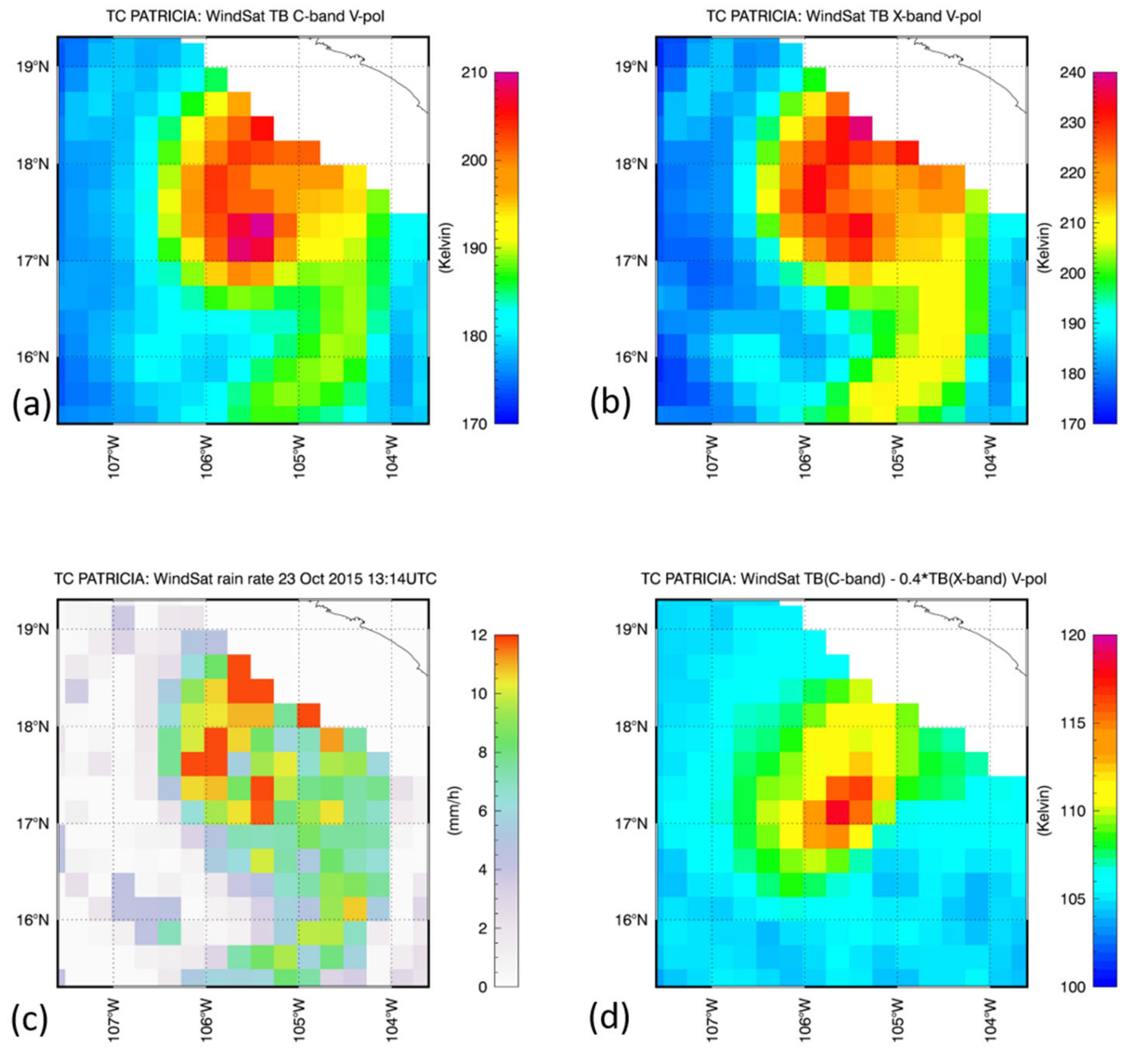

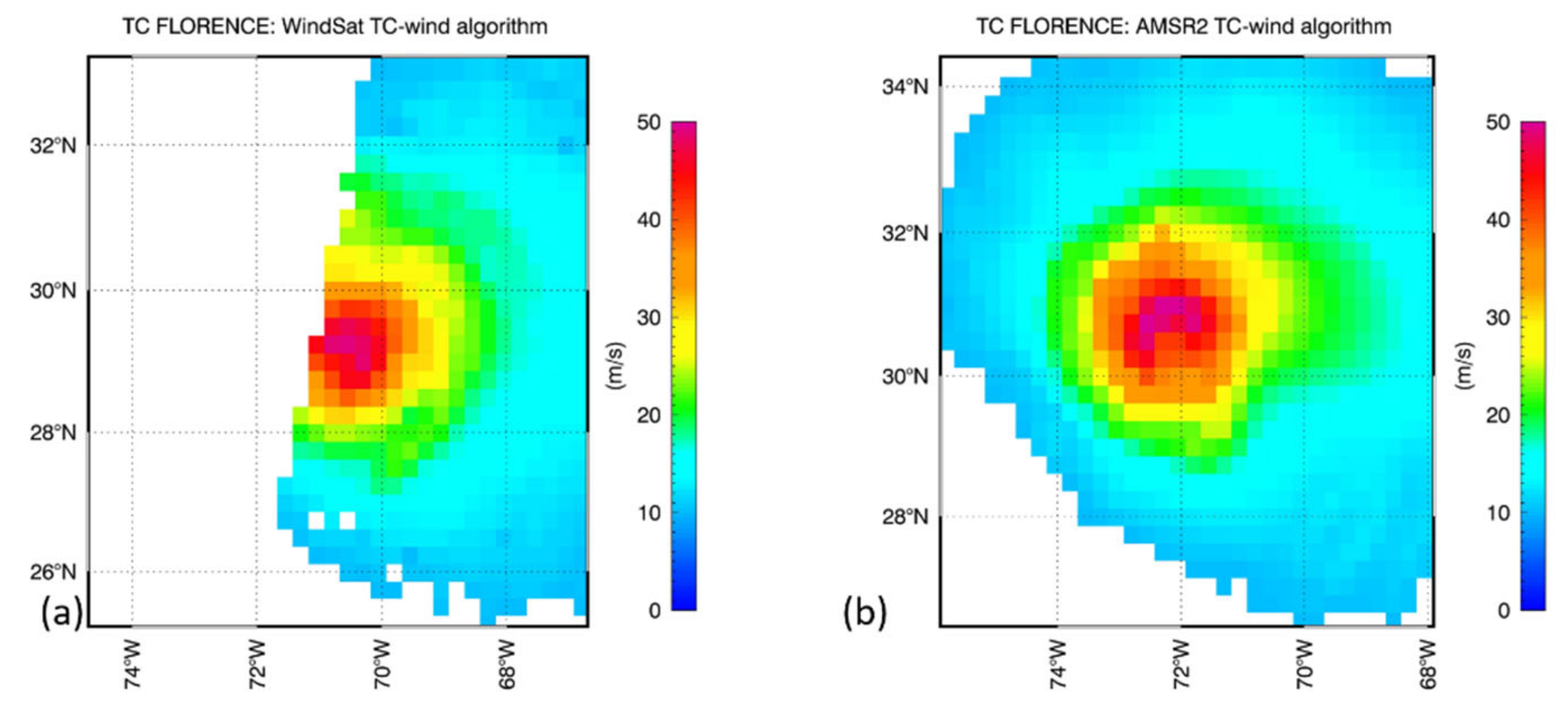
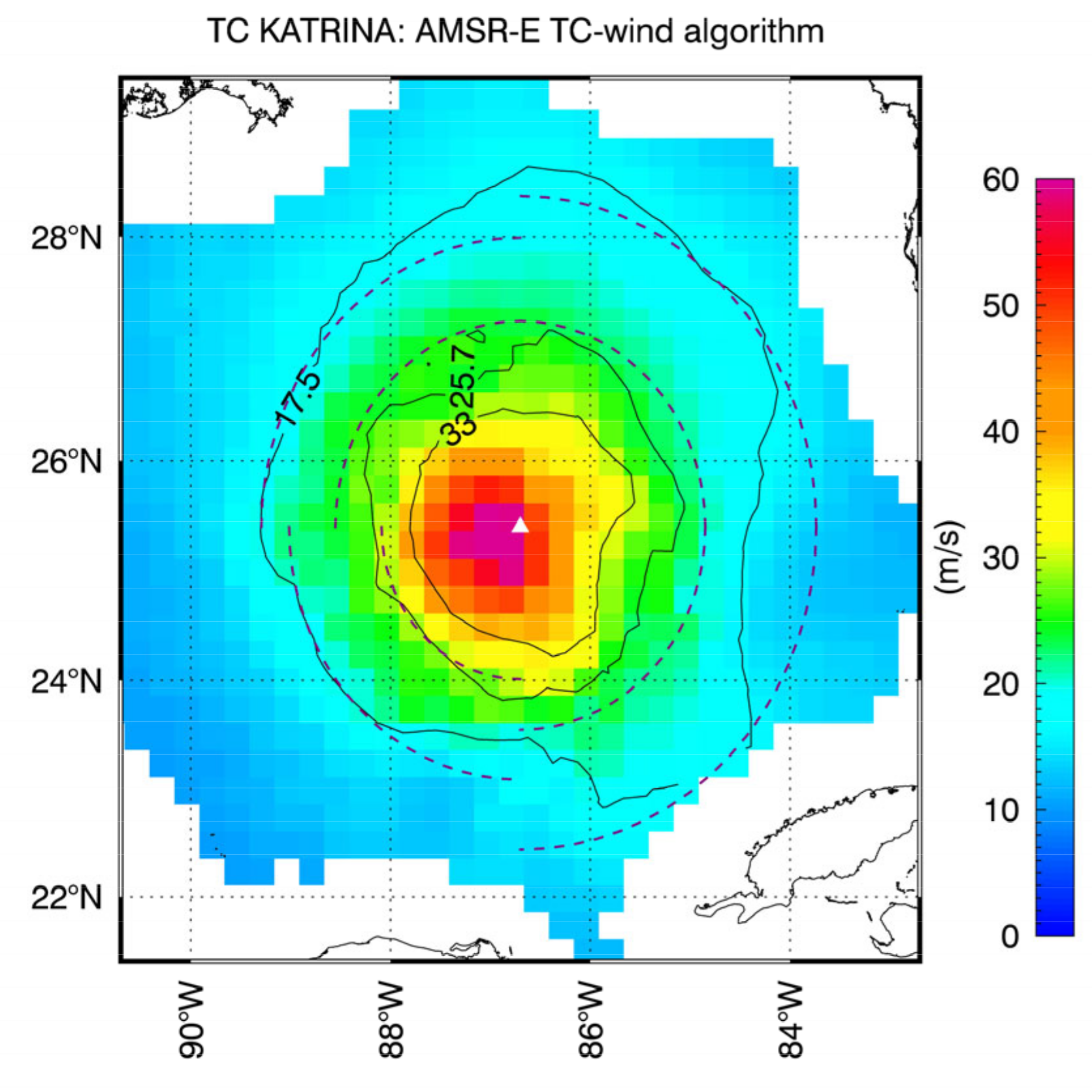
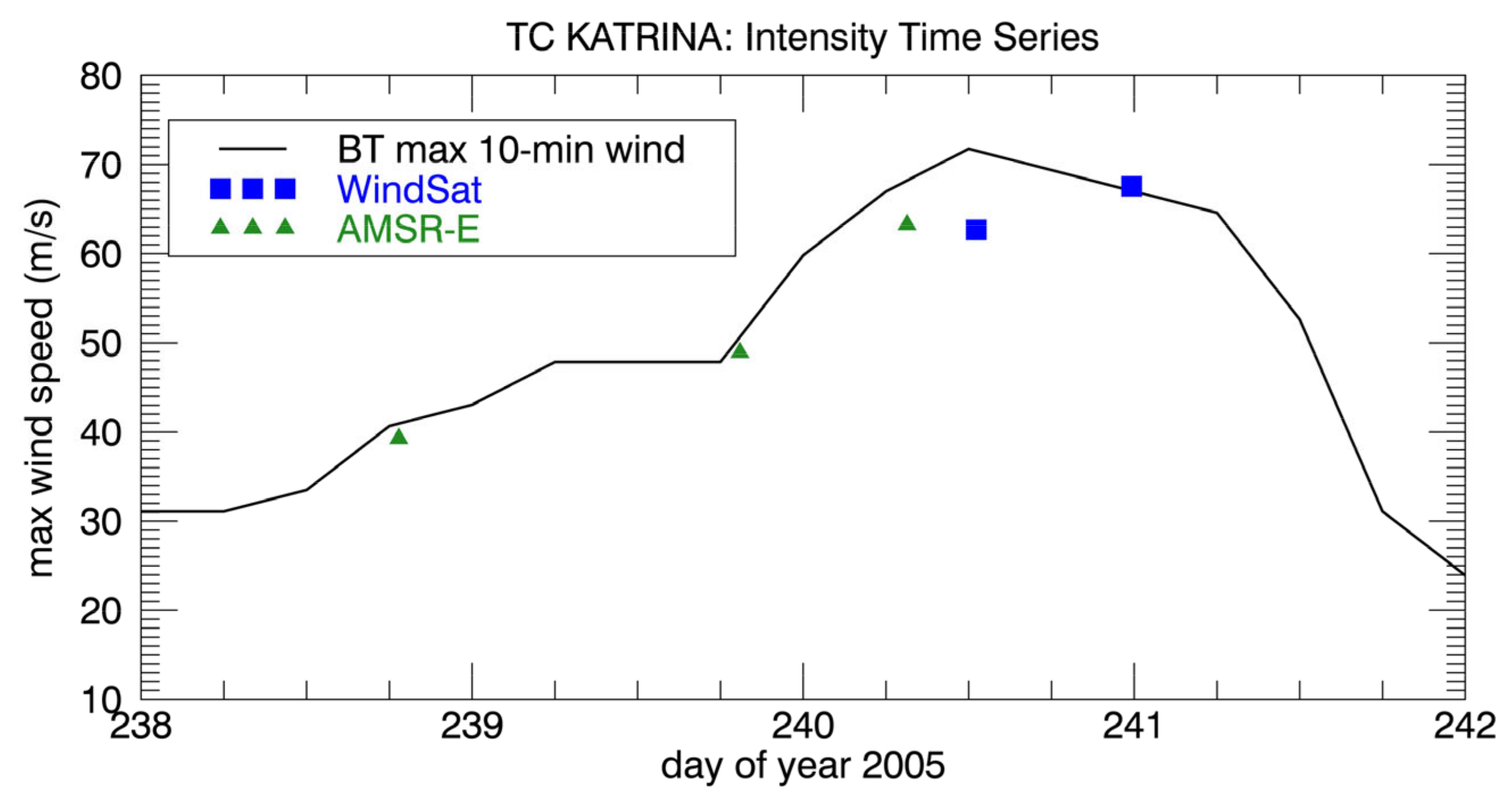
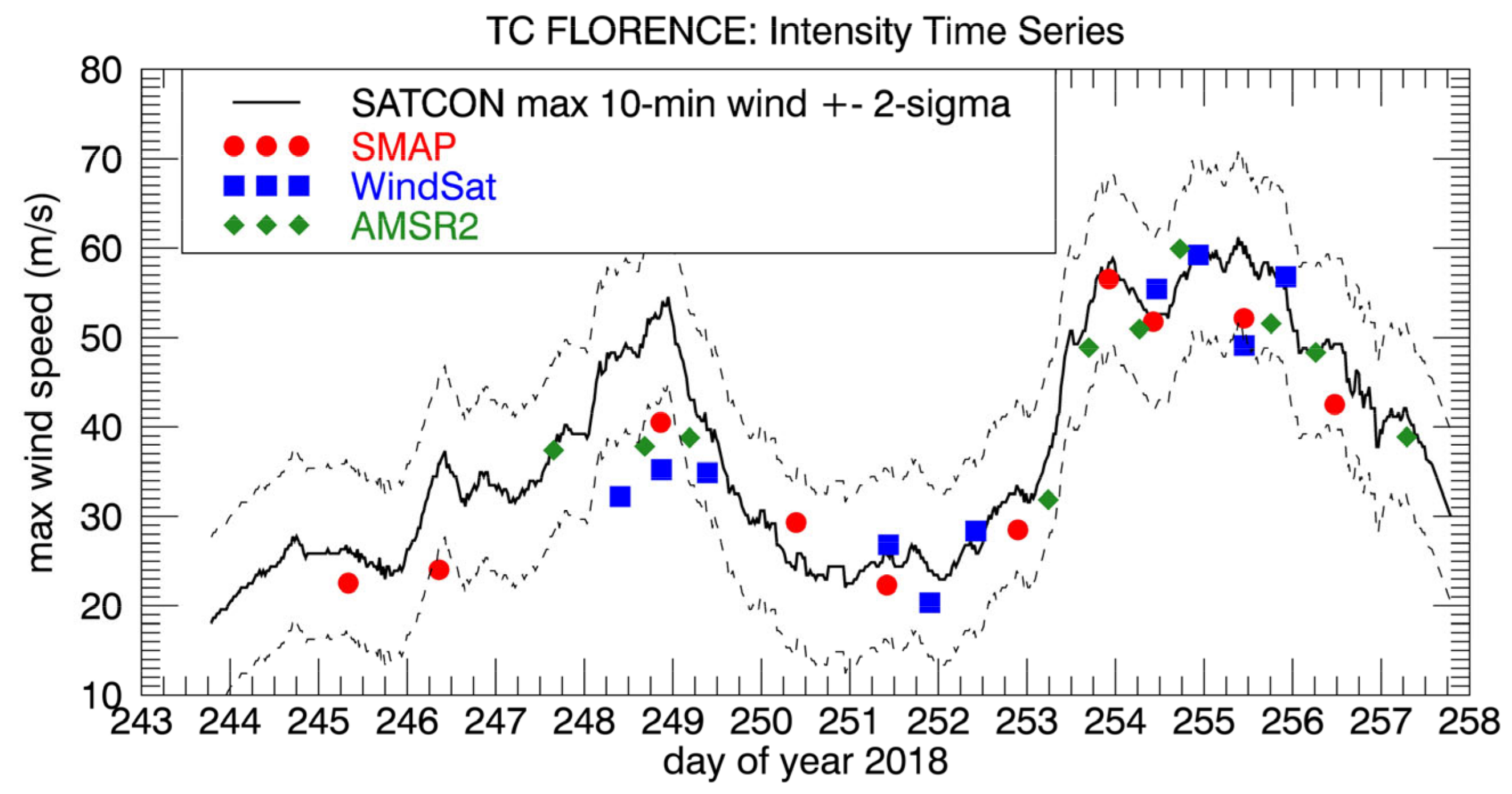
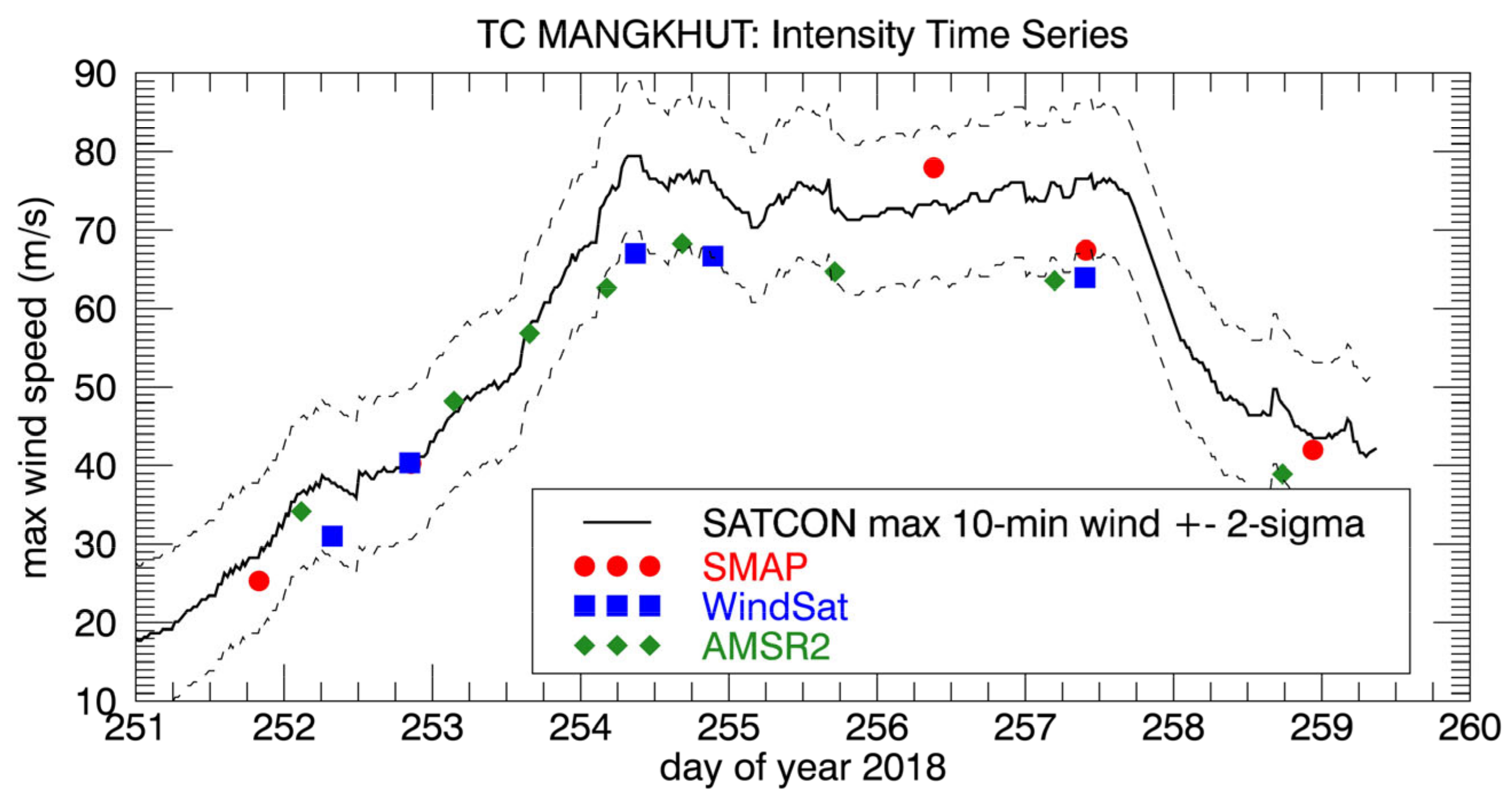
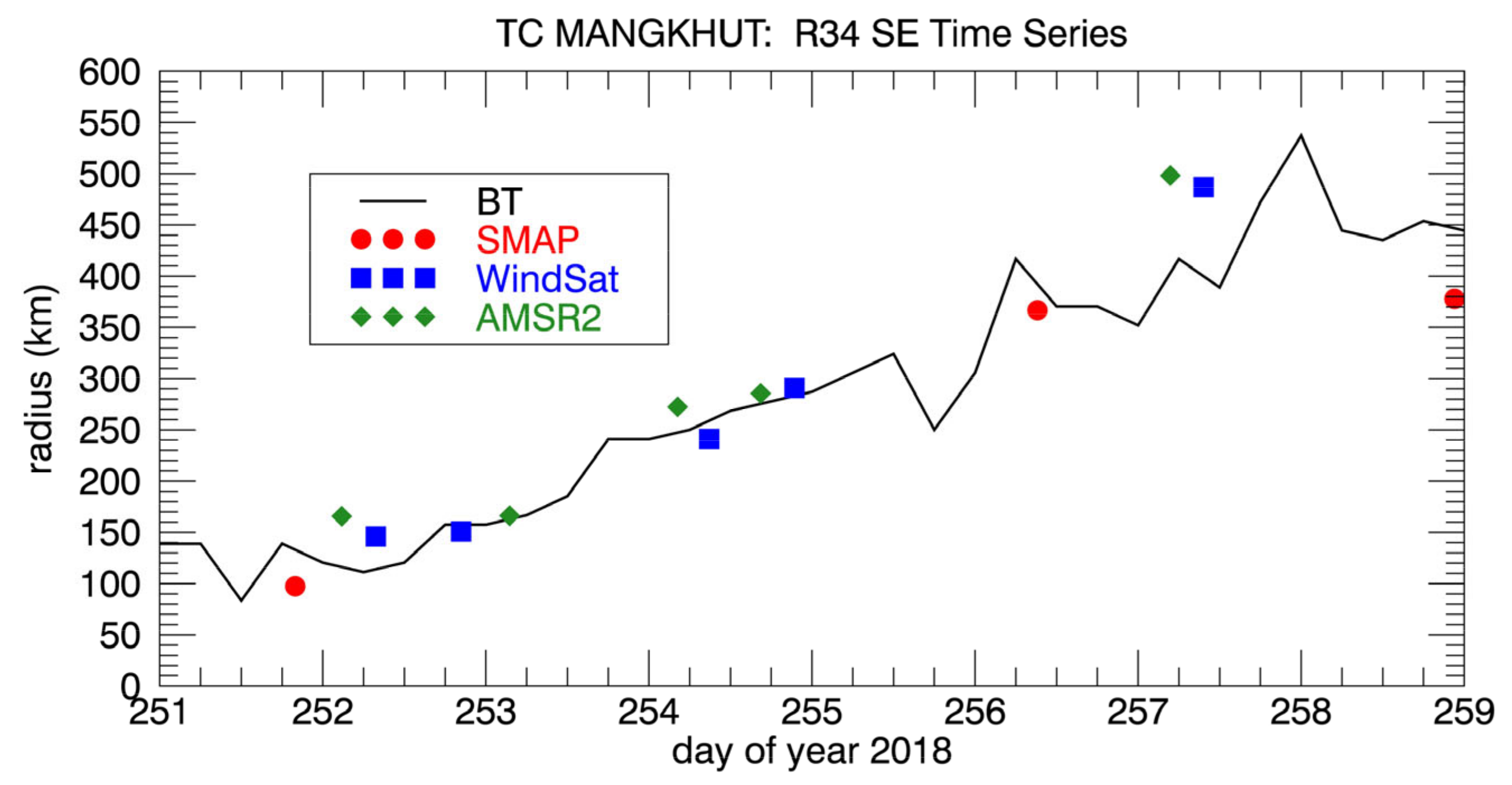
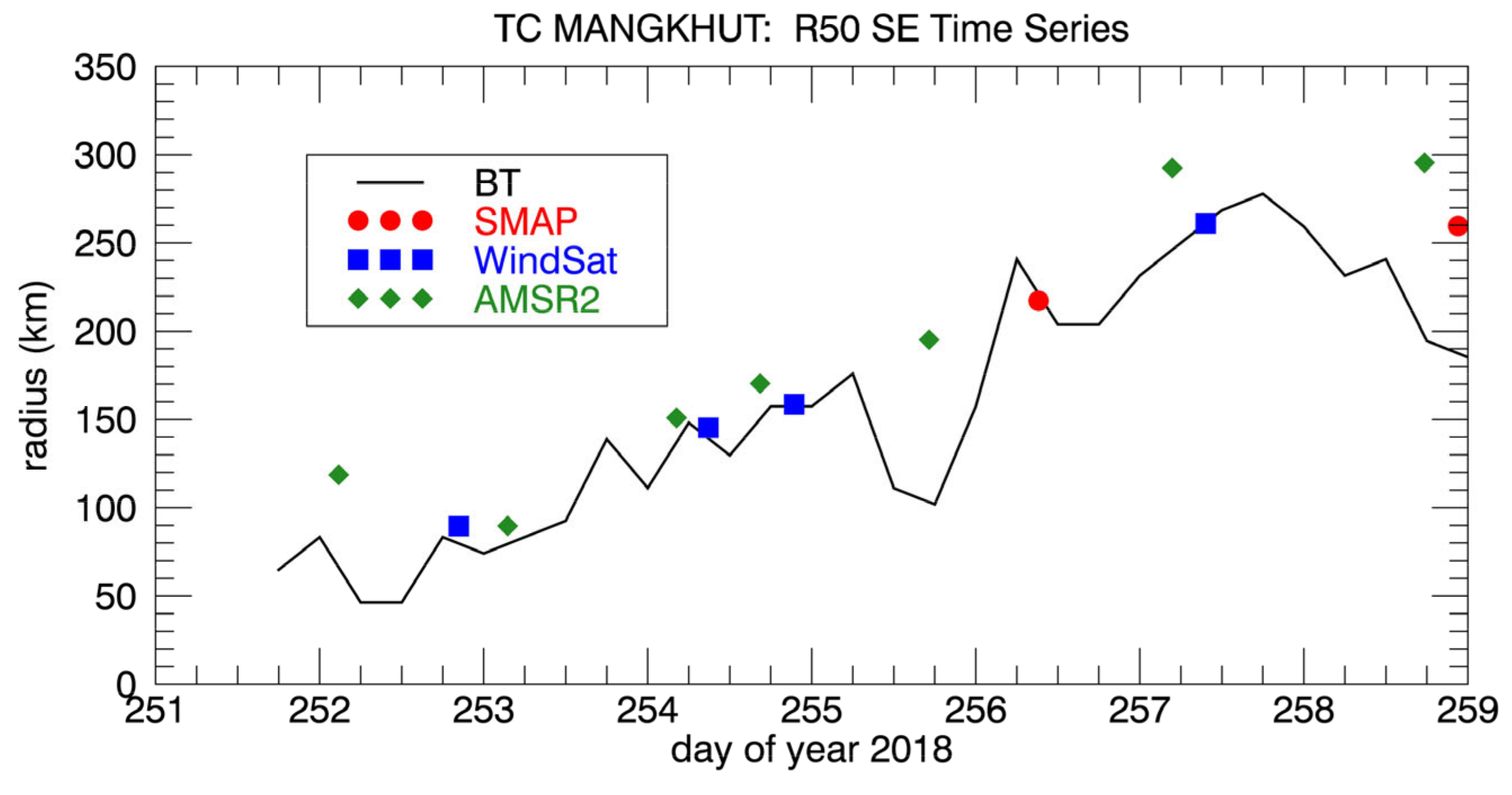

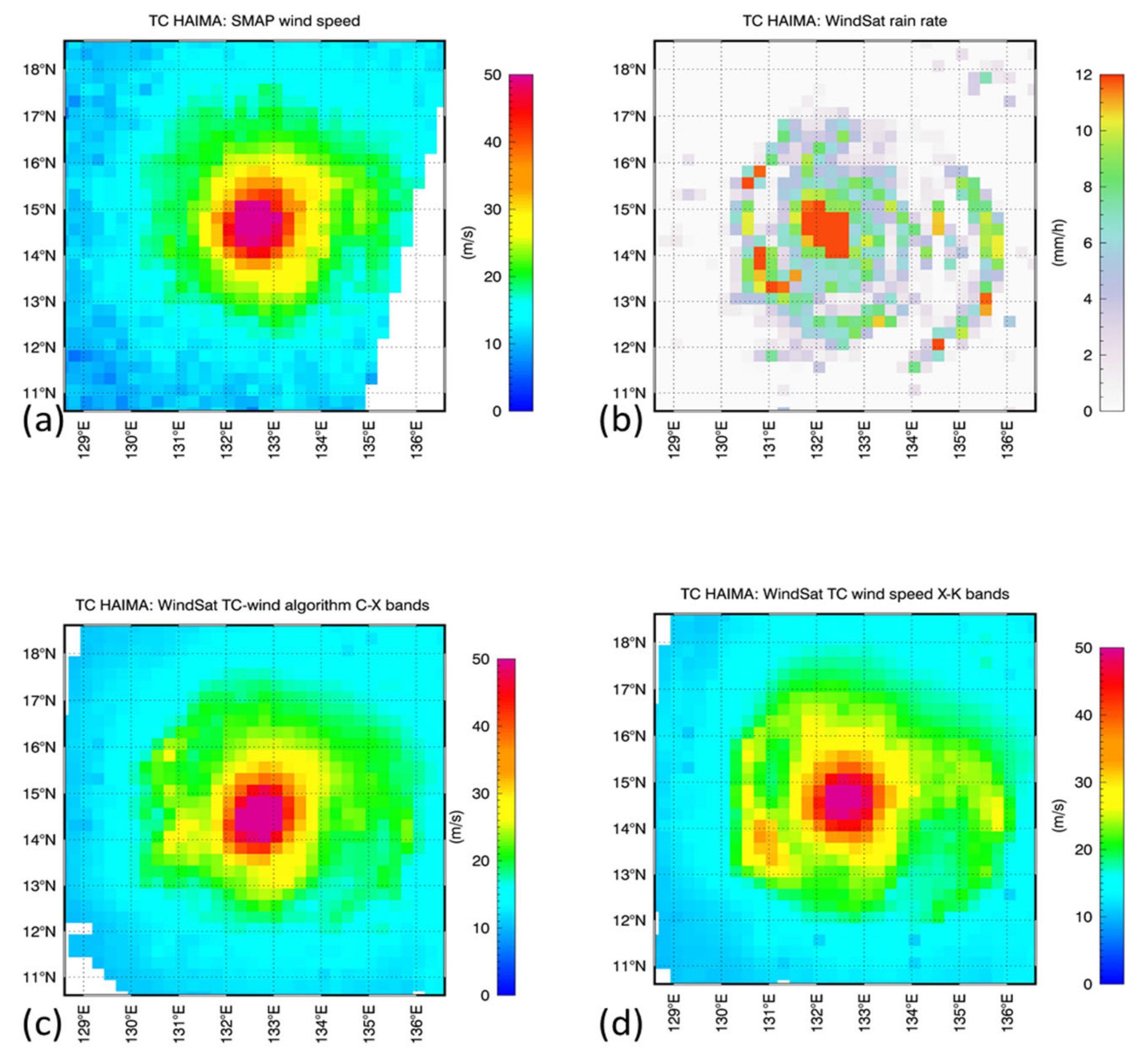

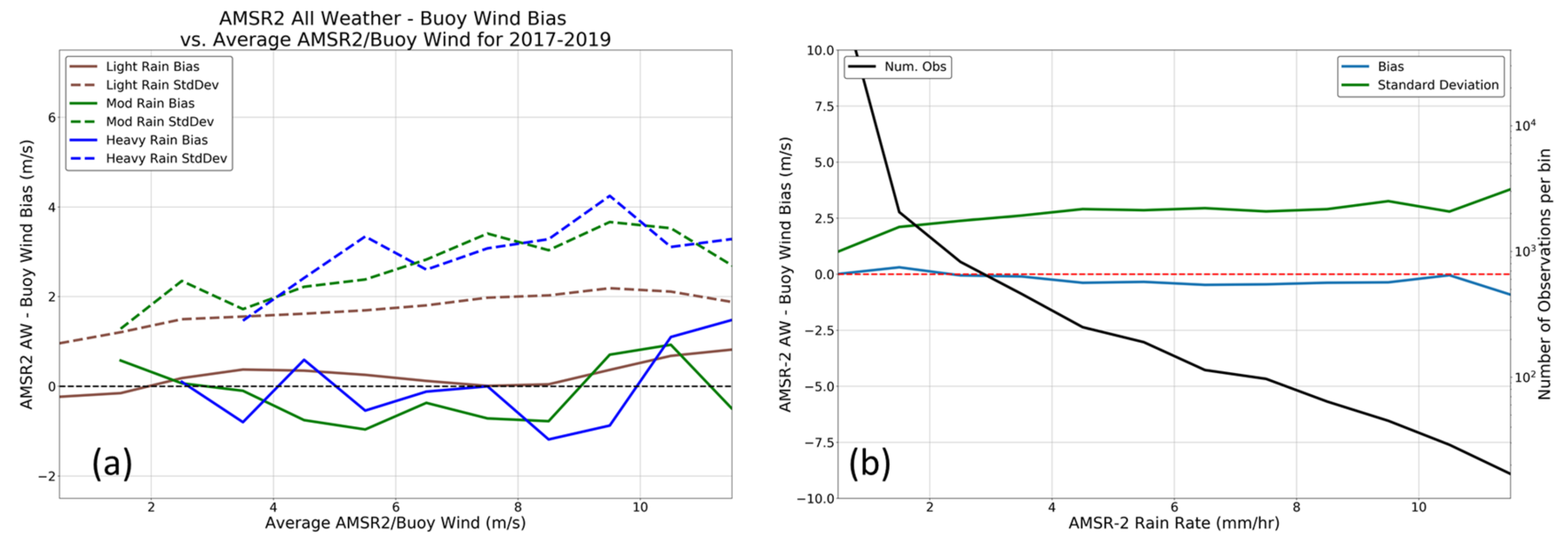
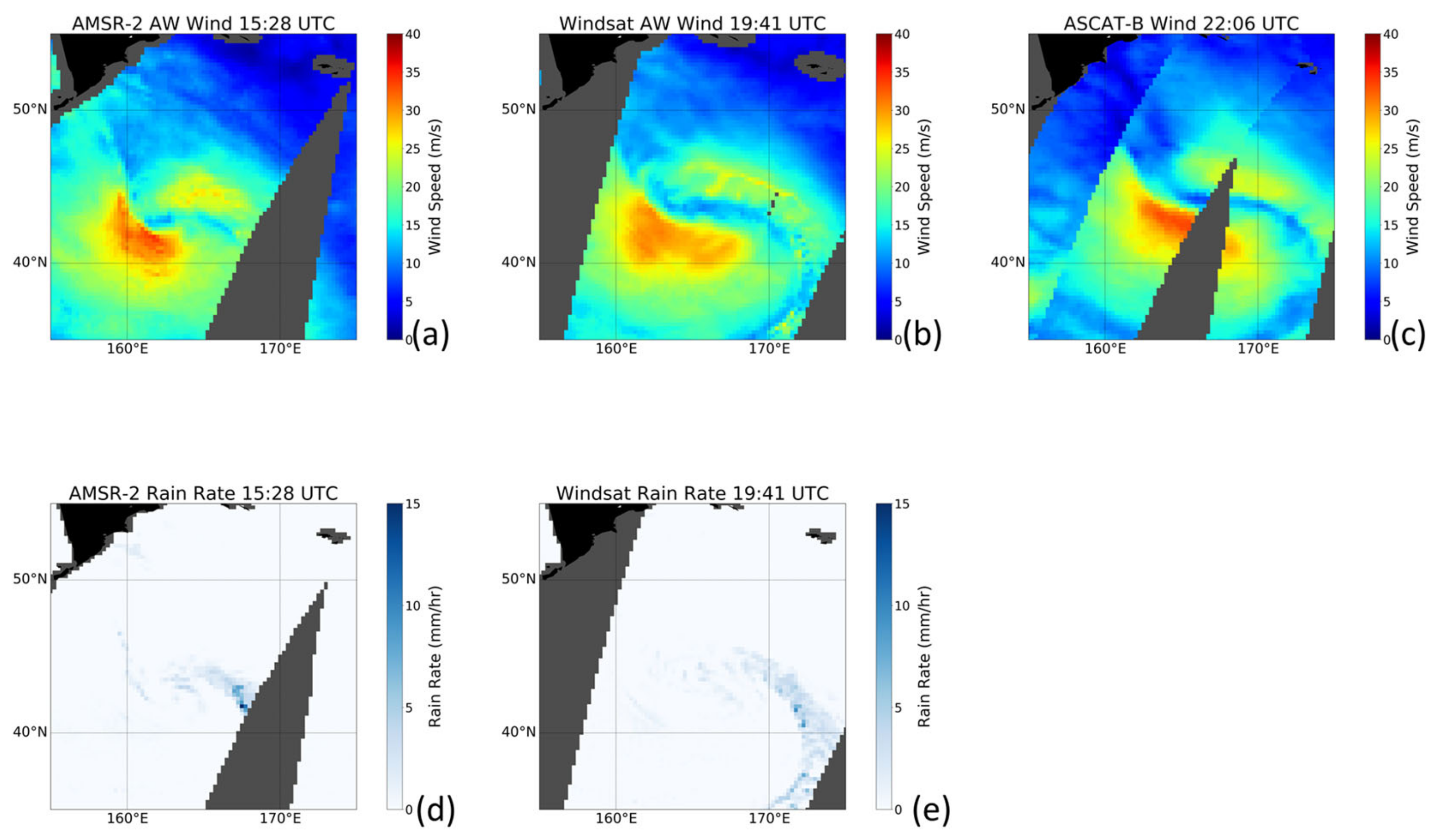
| Rain Rate Interval (mm/h) | Average Rain Rate (mm/h) |
|---|---|
| 0 < R ≤ 1 | 0.2 |
| 1 < R ≤ 5 | 2.5 |
| 5 < R ≤ 9 | 7.0 |
| R > 9 | 12.1 |
| Sensor | Center Frequency C-Band | Center Frequency X-Band | EIA C-Band | EIA X-Band |
|---|---|---|---|---|
| WindSat | 6.8 GHz | 10.7 GHz | 53.7° | 50.1° |
| AMSR-E/AMSR2 | 6.925 GHz | 10.65 GHz | 55.0° | 55.0° |
| R intervals in 1st stage (mm/h) | 0 < R ≤ 0.2. 0.1 ≤ R ≤ 6. 3 ≤ R ≤ 10. R ≥ 10. |
| TS intervals in 1st stage (°C) | −2 ≤ TS ≤7. 5 ≤ TS ≤ 15. 13 ≤ TS ≤ 20. 18 ≤ TS ≤ 26. 25 ≤ TS ≤ 32. |
| R intervals in 2nd stage (mm/h) | 0 < R ≤ 0.2. 0.1 ≤ R ≤ 6. R ≥ 3. |
| TS intervals in 2nd stage (°C) | −2 ≤ TS ≤ 7. 5 ≤ TS ≤ 15. 13 ≤ TS ≤ 20. 18 ≤ TS ≤ 26. 25 ≤ TS ≤ 32. |
| W intervals in 2nd stage (m/s) | 0 ≤ W ≤ 8. 5 ≤ W ≤ 12. 10 ≤ W ≤ 20. W ≥ 17. |
Publisher’s Note: MDPI stays neutral with regard to jurisdictional claims in published maps and institutional affiliations. |
© 2021 by the authors. Licensee MDPI, Basel, Switzerland. This article is an open access article distributed under the terms and conditions of the Creative Commons Attribution (CC BY) license (https://creativecommons.org/licenses/by/4.0/).
Share and Cite
Meissner, T.; Ricciardulli, L.; Manaster, A. Tropical Cyclone Wind Speeds from WindSat, AMSR and SMAP: Algorithm Development and Testing. Remote Sens. 2021, 13, 1641. https://doi.org/10.3390/rs13091641
Meissner T, Ricciardulli L, Manaster A. Tropical Cyclone Wind Speeds from WindSat, AMSR and SMAP: Algorithm Development and Testing. Remote Sensing. 2021; 13(9):1641. https://doi.org/10.3390/rs13091641
Chicago/Turabian StyleMeissner, Thomas, Lucrezia Ricciardulli, and Andrew Manaster. 2021. "Tropical Cyclone Wind Speeds from WindSat, AMSR and SMAP: Algorithm Development and Testing" Remote Sensing 13, no. 9: 1641. https://doi.org/10.3390/rs13091641
APA StyleMeissner, T., Ricciardulli, L., & Manaster, A. (2021). Tropical Cyclone Wind Speeds from WindSat, AMSR and SMAP: Algorithm Development and Testing. Remote Sensing, 13(9), 1641. https://doi.org/10.3390/rs13091641





